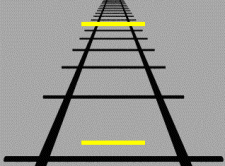
Ponzo illusion
Encyclopedia

Italy
Italy , officially the Italian Republic languages]] under the European Charter for Regional or Minority Languages. In each of these, Italy's official name is as follows:;;;;;;;;), is a unitary parliamentary republic in South-Central Europe. To the north it borders France, Switzerland, Austria and...
psychologist Mario Ponzo
Mario Ponzo
Mario Ponzo was an Italian academic psychologist. He was born in Rome and studied under Federico Kiesow at Turin where, in 1911, he published an article in the journal Archives Italiennes de Biologie which presented the well-known optical illusion known as the Ponzo illusion...
(1882–1960) in 1913. He suggested that the human mind judges an object's size based on its background. He showed this by drawing two identical lines across a pair of converging lines, similar to railway tracks. The upper line looks longer because we interpret the converging sides according to linear perspective as parallel lines receding into the distance.
In this context, we interpret the upper line as though it were farther away, so we see it as longer – a farther object would have to be longer than a nearer one for both to produce retinal images of the same size.
Some researchers believe that the Moon illusion
Moon illusion
The Moon illusion is an optical illusion in which the Moon appears larger near the horizon than it does while higher up in the sky. This optical illusion also occurs with the sun and star constellations. It has been known since ancient times, and recorded by numerous different cultures...
is an example of the Ponzo illusion, with trees and houses playing the role of Ponzo's converging lines. Foreground objects trick our brain into thinking the moon is bigger than it really is.
One of the explanations for Ponzo illusion is the 'Perspective hypothesis', which states that the perspective feature in the figure is obviously produced by the converging lines ordinarily associated with distance, that is, the two oblique lines appear to converge toward the horizon or a vanishing point. Another is the 'Framing effects hypothesis', which says that the difference in the separation or gap of the horizontal lines from the framing converging lines may determine, or at least contribute to the magnitude of the distortion.
This typical visual illusion also occurs in touch and with an audition-to-vision sensory substitution device
Sensory substitution
Sensory substitution means to transform the characteristics of one sensory modality into stimuli of another sensory modality. It is hoped that sensory substitution systems can help handicapped people by restoring their ability to perceive a certain defective sensory modality by using sensory...
. However, prior visual experience seems mandatory to perceive it as demonstrated by the fact that congenitally blind subjects are not sensitive to it.
Cross-cultural differences in susceptibility to the Ponzo illusion have been noted, with non-Western and rural people showing less susceptibility. Other recent research suggests that an individual's receptivity to this illusion, as well as the Ebbinghaus illusion
Ebbinghaus illusion
The Ebbinghaus illusion or Titchener circles is an optical illusion of relative size perception. In the best-known version of the illusion, two circles of identical size are placed near to each other and one is surrounded by large circles while the other is surrounded by small circles; the first...
, may be inversely correlated with the size of that individual's primary visual cortex.

